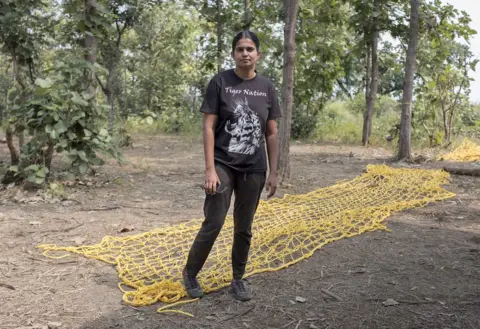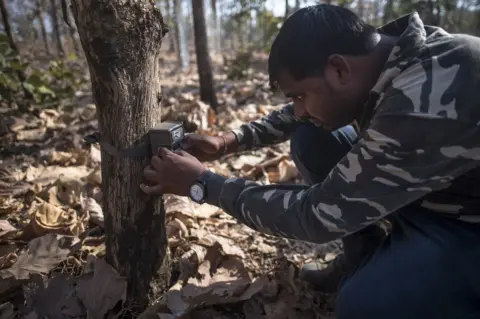Can Calvin Klein scent catch a 'killer' tiger?
 Getty Images
Getty ImagesCan a world-famous eau de toilette for men, known for its smoky and spicy fragrance, help trap a "man-eating" tiger prowling in the jungles of India's western state of Maharashtra?
Wildlife officials say they aren't sure, but have in any case bought bottles of Obsession for Men by Calvin Klein to lure a six-year-old tigress that is believed to have killed 13 people around the town of Pandharkawada. She has been evading capture for more than two years.
"We have been told the cologne can work as a good scent bait for the tigress. So we will spray the perfume on the trees and ground and see what happens," Sunil Limaye, a wildlife official, says.
The fragrance contains a pheromone called civetone derived from the scent glands of a cat-like mammal called the civet, which is often used in cologne. During an experiment at New York's Bronx Zoo, jaguars apparently loved the perfume.
Biologist Miguel Ordenana told the Scientific American magazine that he believed jaguars could be lured to a camera trap by spraying the perfume on a tree branch. Three years ago, the perfume - sprayed on camera traps and cages - was used to trap a leopard in southern Karnataka state.
Using an expensive perfume to lure a tiger hints at the acute desperation that is building up to capture the big cat, simply named T-1, in what has become one of India's biggest tiger hunts ever.
The search has frustrated forestry officials and sharpshooters as the tigress - along with her two nine-month-old cubs - continues to skulk in a vast 150 sq km (57 sq miles) area covering jungles, farms and villages.
 Pratik Chorge/Hindustan Times
Pratik Chorge/Hindustan TimesFear has gripped more than 5,000 people living in 20 villages in the area after three killings in August. To avoid tiger attacks, farmers and graziers are being told to return early from the fields and forest, venture out only in groups, and not defecate in the open fields, a common practice in the villages.
Animal activists in cities have begun a social media and online campaign to "save" the tigress from the hunter's gun, saying that forestry officials don't have the expertise to capture the cat alive and will end up shooting it.
But, in September, India's Supreme Court waded in, saying it would not interfere if the forest rangers were forced to shoot the tiger while trying to capture it.
"We do not intend to kill her. But it will all depend on the circumstances. If she attacks us, we'll have to shoot. It's a game of wait and watch," AK Mishra, the senior-most wildlife official in the region, says.
The "game" has gone on for too long, say officials, and they have done nearly everything possible to track down the tigress.
Thirty-six forest guards go into the forest every day to check more than 100 camera traps that have so far turned up more than 300 images of T-1 and her cubs. At a dozen places in the jungle, horses and goats have been tied to trees as bait. Two horses have been already killed - presumably by the tigress - in October but a search of the areas proved to be futile.
Rangers with torches and wireless sets keep watch from four treetop platforms round the clock. Fifty commandos of a "tiger protection force", along with policemen armed with AK-47s. patrol the forests.
They look for fresh pugmarks, sniff out tiger urine, and identify claw marks on tree barks, where tigers polish their retractable claws. A hired sharpshooter has also been moving around separately with his nine-member team. Elephants have also been deployed. A drone and a power glider are flying over the jungle to try to spot the cat.
 Kannagi Khanna
Kannagi KhannaAt the rag-tag makeshift camp in Sitara village on the edge of the forest, three cages and nylon nets are ready to be transported to any area to capture and bring back the cats.
A group of vets are on hand with tranquiliser darts. In all, 500 men and an array of machines have been pressed into service. And yet, T-1 continues to evade capture.
"She is very clever. She is with her cubs, so she is extra careful. She manages to outwit us," says KM Abharna, a senior forestry official who is co-ordinating the hunt.
"The terrain doesn't make the job any easier for us."
The teak forest is undulating and rocky. The biggest obstacle is a fast-growing wild shrub called lantana that sometimes grows to heights of 8-10ft. This wild bush makes it difficult for the team to navigate by foot or by vehicle and comes in the way of spotting animals. Panthers, blue bulls, wild pigs and snakes populate the jungle. During the sticky summers, temperatures soar to 48C (118F) and quickly exhaust the hunters.
The hunt has also brought tragedy in its wake. Earlier this month, five elephants were brought in to carry sharpshooters to spot, cordon off and capture the tigress. The operation ended abruptly when one of the elephants broke away from her shackles, and trampled a village woman to death. The pachyderms were quickly sent back amid villager outrage.
"The search goes on. We have to be patient," says Mr Limaye.
 Kannagi Khanna
Kannagi Khanna
There are other questions to which answers remain unclear.
For one, it is not clear where T-1 came from, apart from the fact that she was not born in a protected reserve. They also know that her mother was electrocuted when she came into contact with a crude electric fence. Farmers often set these up around their land to keep away marauding animals.
With more than 2,200 big cats, India is home to 60% of the world's tigers. There are more than 200 in Maharashtra, but only a third of them live in the state's 60 protected areas, including sanctuaries, natural parks and tiger reserves.
And there is still some confusion about whether T-1 deserves the "man-eater" label.
She is believed to have killed 10 people in 20 months since 2016. Things came to a head in August when she allegedly killed three people, sparking panic in the area. DNA tests on swabs from tiger saliva from the wounds of seven of the 13 victims so far show that five of them were inflicted by a female tiger. The two other samples turned up inconclusive results.
Many of the bodies were decapitated as she dragged her prey away. She appears to have tasted human flesh: at least one victim was found with his leg torn off.
Also, it is not clear why T-1 has attacked humans.
Rapid deforestation has resulted in tigers often coming into conflict with villagers who live close to their reserves.
But one of the reasons why T-1 is allegedly attacking humans is the abnormally high numbers of cattle being taken to graze in the forests.
 Pratik Chorge/Hindustan Times
Pratik Chorge/Hindustan TimesVillagers in the area are holding on to an estimated 30,000 cattle, most of them old and unproductive animals that herders cannot kill because of a government ban on cow slaughter. Villagers are forced to graze them in the forest as there is little fodder at home. Many of the attacks appear to be chance encounters gone wrong, or simply because the humans got in the way of their real prey - the cattle.
'Blood sucking tiger'
In January, Ramji Shendre, 70, and his wife went to the jungle with their two cattle. As Shendre lit a fire from the wood he had collected to ward off insects, the tigress suddenly appeared behind him. Some 50 metres away, his wife Lata watched in horror as the tiger dragged her husband's body away. She climbed a rickety platform and screamed for help.
Villagers rushed to the area, vehicles were stopped on a neighbouring road and air-horns were blown. The tiger dragged the body for 2km and abandoned it.
"She doesn't eat her victims, it seems," Lata says. "She just sucks the blood out of her human prey". Most villagers call her the "blood sucking tiger". But officials say she has eaten the flesh of many of her victims.
And yet the hunters nearly got her on 21, May.
 Kannagi Khanna
Kannagi KhannaThe search group had spotted her 18km away from the camp at Sarati, feasting on a blue bull. They surrounded her, says Ms Abharna, and shot her with a tranquiliser dart.
The dart struck her.
But she turned around, swam across a narrow dam, bolted across farms, crossed a macadam road, and disappeared into the forest. Officials say she may have been in a state of heightened excitement which would have made the tranquiliser ineffective. Or the dosage of the dart was simply not enough.
When the rangers backed up their 4x4, T-1 was on the road and "charged" at the vehicle, remembers Ms Abharna.
"She was roaring loudly. She was very, very angry."
Then she dashed into the lantana bushes and disappeared.
